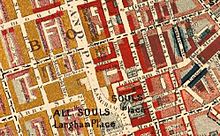|
Portland Place
Portland Place is a street in the Marylebone district of central London. Named after the 3rd Duke of Portland, the unusually wide street is home to the BBC's headquarters Broadcasting House, the Chinese and Polish embassies, the Royal Institute of British Architects and numerous residential mansion blocks. History and topography  The street was laid out by the brothers Robert and James Adam for the Duke of Portland in the 1770s and originally ran north from the gardens of a detached mansion called Foley House. It was said that the exceptional width of the street was conditioned by the Duke's obligation to his tenant, Lord Foley, that his views to the north would not be obscured.[1] In the early 19th century, Portland Place was incorporated into the royal route from Carlton House to Regent's Park via Langham Place, developed for the Prince Regent by John Nash. The street is unusually wide for central London (33 metres / 110 feet).[2] The ambitious plans included a third circus to complement Piccadilly Circus and Oxford Circus known as Regent's Circus; the remains of this plan survive today in the wide space surrounding the street's junction with Marylebone Road.[3] The Spanish Embassy was located at Portland Place from 1819 to 1821.[4] Portland Place still contains many of the spacious Georgian terraced houses built by the Adams, as well as some early 20th century buildings and a few post World War II bombing In administrative terms, Portland Place lies within the City of Westminster's Marylebone High Street Ward as well as the Harley Street Conservation Area.[5] Residents and buildings   While most is high quality residential in a close local community, many of the houses are now occupied by company headquarters, professional bodies, embassies and charities (including Arthritis Research UK and the Royal Air Force Benevolent Fund). The landmark headquarters of the Royal Institute of British Architects sits at 66 Portland Place directly opposite the Chinese embassy; for years practitioners of Falun Gong have mounted a silent protest in front of the former and facing the latter. Other foreign diplomatic institutions include the Polish Embassy, a Portuguese consulate, the High Commission of Kenya, the Swedish Ambassador's Residence and the Colombian Consulate. In addition, Portland Place remains a fashionable address with some very exclusive blocks of mansion flats. Number 1 houses the Institution of Chemical Engineers, number 41 the Academy of Medical Sciences, number 23 houses the Nursing and Midwifery Council, number 67 the Royal Air Force Benevolent Fund and number 76 the Institute of Physics. The Institute of Physics building replaced two earlier Georgian terrace houses, one of which – number 76 – was the home of John Buchan, the author and politician who lived there from 1912 until 1919, which resulted in Portland Place being the London home of Richard Hannay, the hero of Buchan's most famous novel "The Thirty-Nine Steps".[6] Its northern end opens into Nash's elegant stucco semicircular Park Crescent, which in turn leads on to Park Square and Regent's Park. There are two landmark buildings at the south end of the street, although both are technically in Langham Place: the grand late Victorian Langham Hotel, and Broadcasting House. Langham Place is a short road which connects Portland Place to Upper Regent Street, although on the ground they all appear to be one street. A Grade II listed memorial to Quintin and Alice Hogg erected in 1906 stands opposite Broadcasting House at the south end of Portland Place.[7] There are a number of international independent schools on Portland Place, including Abercorn Upper School, Queens College and the Southbank International School. Literary references
See also
References
BibliographyGeorgian London (1945) by Sir John Summerson ISBN 0-7126-2095-8 Philip Temple, Colin Thom, Andrew Saint (2017) Survey of London: South-East Marylebone Volumes 51 and 52, Yale University Press, pp. 944 Edward Walford (1878) 'Oxford Street and its northern tributaries: Part 2 of 2', in Old and New London: Volume 4 , pp. 441-467 External links
|
||||||||||||||||
